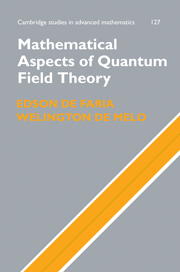Book contents
- Frontmatter
- Contents
- Foreword
- Preface
- 1 Classical mechanics
- 2 Quantum mechanics
- 3 Relativity, the Lorentz group, and Dirac's equation
- 4 Fiber bundles, connections, and representations
- 5 Classical field theory
- 6 Quantization of classical fields
- 7 Perturbative quantum field theory
- 8 Renormalization
- 9 The Standard Model
- Appendix A Hilbert spaces and operators
- Appendix B C* algebras and spectral theory
- Bibliography
- Index
5 - Classical field theory
Published online by Cambridge University Press: 05 March 2013
- Frontmatter
- Contents
- Foreword
- Preface
- 1 Classical mechanics
- 2 Quantum mechanics
- 3 Relativity, the Lorentz group, and Dirac's equation
- 4 Fiber bundles, connections, and representations
- 5 Classical field theory
- 6 Quantization of classical fields
- 7 Perturbative quantum field theory
- 8 Renormalization
- 9 The Standard Model
- Appendix A Hilbert spaces and operators
- Appendix B C* algebras and spectral theory
- Bibliography
- Index
Summary
The concept of field is central in modern physics. In this chapter, we study the basic classical fields, such as the electromagnetic field, presenting them from a unified mathematical perspective. The expression “classical field” is used here in contradistinction to “quantum field” (a concept to be defined in Chapter 6), and is taken to mean “field before quantization.” Thus, we treat fermionic fields as classical, even though strictly speaking fermions are bona fide quantum objects, with no actual classical counterpart.
Introduction
As we shall see, all such fields arise as sections of certain bundles over the spacetime manifold. The basic paradigm was introduced by Yang and Mills in their fundamental paper (see [tH2]). The central idea of Yang–Mills theory is that there is a background field (such as the electromagnetic field) that is given by a connection A defined on a principal bundle over spacetime. The structural group of this bundle represents the internal symmetries of the background field. The possible interactions – also called couplings – of the background field with, say, particles such as photons or electrons are dictated by the representations of the group. Each particle field turns out to be a section of the associated vector bundle constructed from the principle bundle with the help of a given representation of the group. These fields, say φ, ψ, …, together with the background connection, should satisfy a variational principle. In each case, we have a Lagrangian L = L(A, φ, ψ, …) defined on the product of the spaces of sections of the bundles corresponding to each field, and taking values in the space of volume forms in the spacetime M.
- Type
- Chapter
- Information
- Mathematical Aspects of Quantum Field Theory , pp. 93 - 116Publisher: Cambridge University PressPrint publication year: 2010



